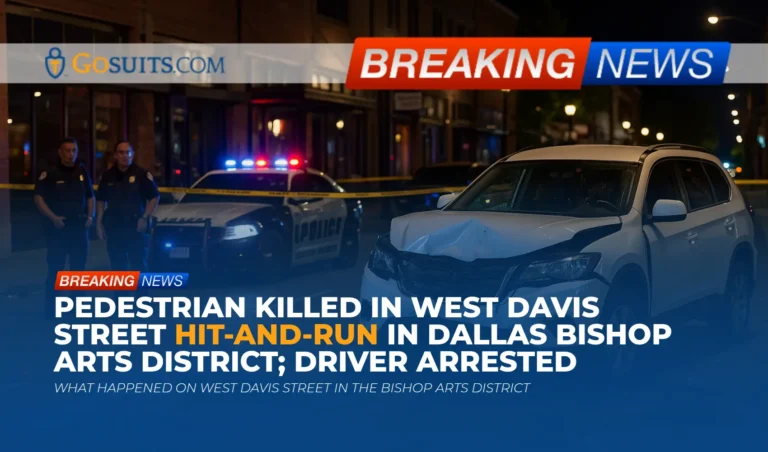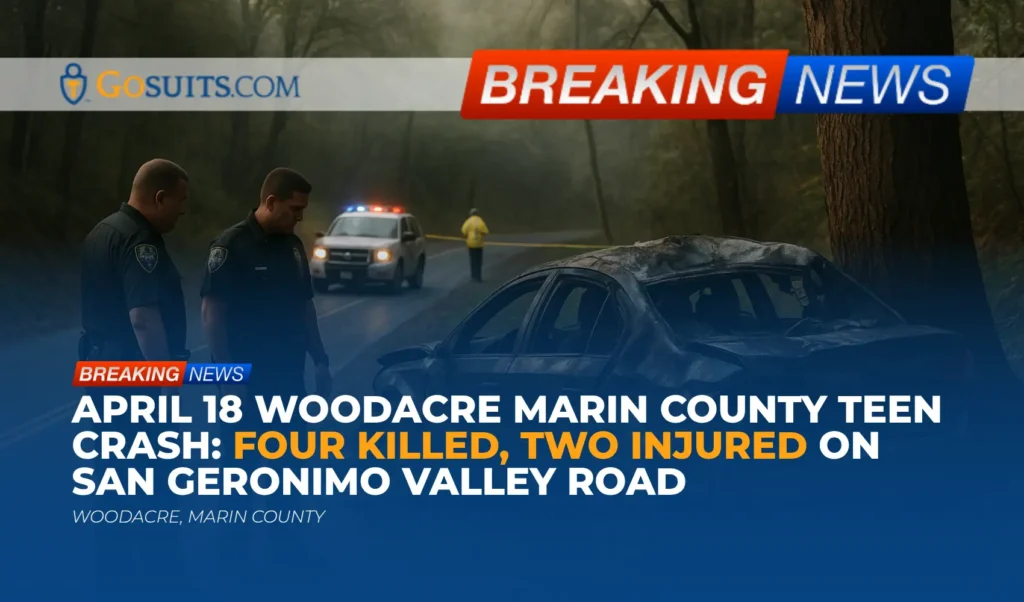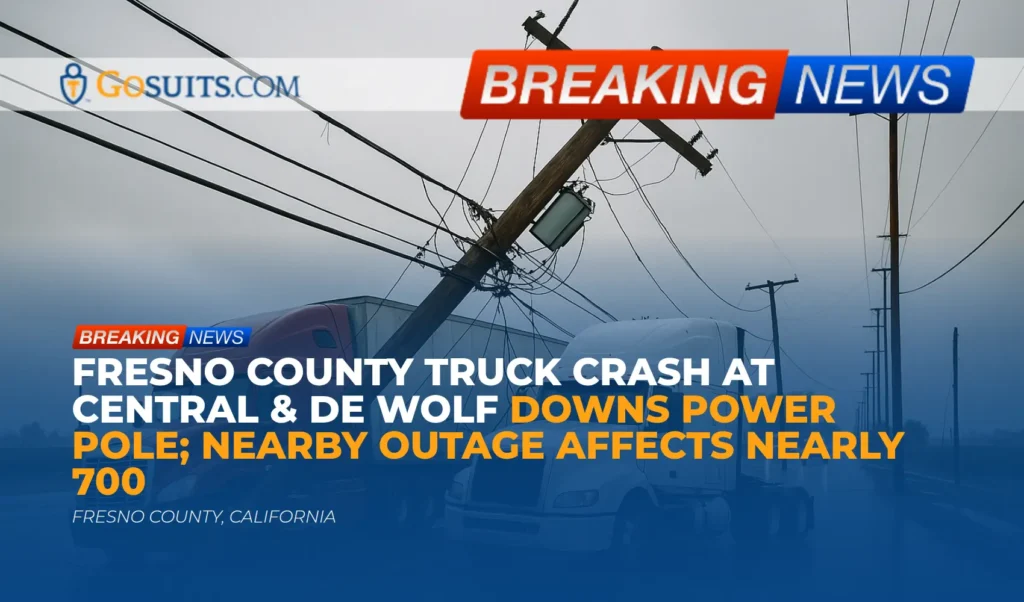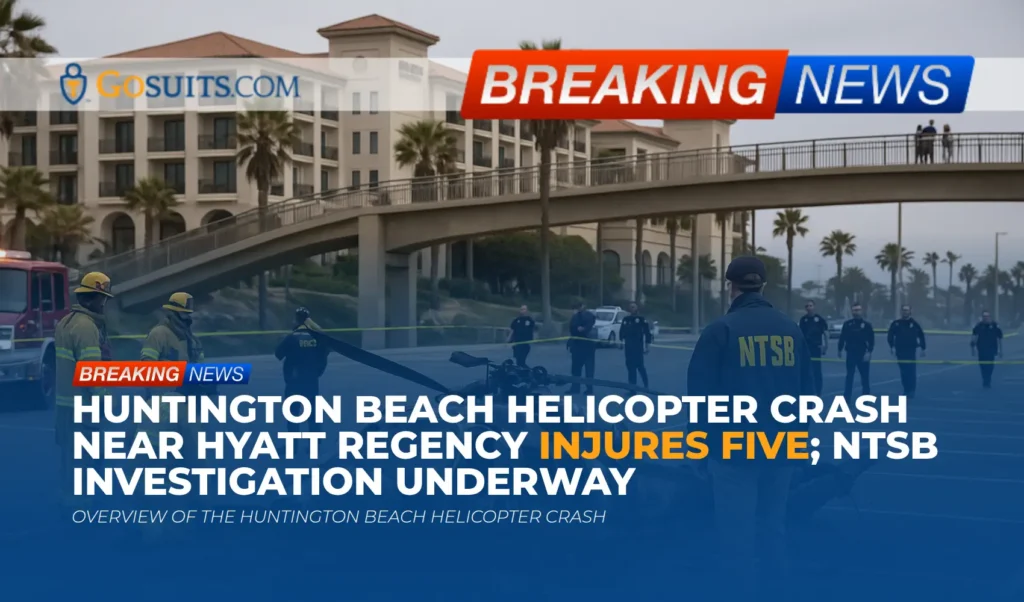- What happened on West Davis Street in the Bishop Arts District
- Where and when the crash occurred, and who was involved
- Law enforcement statements and on-scene observations
- Texas laws that relate to hit-and-run and pedestrian safety
- Civil liability questions after a pedestrian fatality in Texas
- Evidence that should be preserved as soon as possible
- Where to request official records and information
- Insurance considerations after a fatal pedestrian crash in Texas
- Community safety and proven measures that reduce pedestrian harm
- Grief, practical next steps, and timelines
- Commentary from Gosuits Dallas, Texas Personal Injury Attorney
- Important action steps now
What happened on West Davis Street in the Bishop Arts District
According to local reporting, a pedestrian was struck and killed in the Bishop Arts District of Dallas late Sunday night. Police say a white SUV traveling on West Davis Street hit a 29-year-old man who was crossing the roadway. The SUV then collided with a parked vehicle. The driver reportedly fled on foot and was located about an hour later roughly a mile from the scene, after which he was medically evaluated and booked into jail.
Friends at the scene told officers their companion had parked and was walking to meet them at a nearby taqueria when the crash occurred. Video from the area appears to show a white SUV prior to impact, and images from the scene depict severe front-end damage and debris in the roadway. Authorities have identified the pedestrian as 29-year-old Jose Benitez. Police have named the driver as 29-year-old John Alvarez.
This incident sits at the intersection of traumatic loss and urgent questions. Families and communities often want to understand how the crash happened, what laws may apply, and what steps can be taken to preserve information and protect rights. The sections below provide practical information rooted in publicly available sources and Texas law, with respect for everyone affected.
Where and when the crash occurred, and who was involved
Location: 400 block of West Davis Street, Bishop Arts District, Dallas, Texas. Time: approximately 10:30 p.m., Sunday night. Responding officers found the pedestrian unresponsive and he was pronounced deceased at the scene.
Victim: 29-year-old pedestrian, identified by police as Jose Benitez. Based on accounts shared with reporters, he had just parked and was crossing the street to meet friends.
Driver: 29-year-old driver of a white SUV, identified by police as John Alvarez. Police say he left the scene on foot and was later found. He was taken to a hospital for medical clearance and transported to jail.
Vehicle evidence: Photos and videos show a white SUV with significant front-end damage, consistent with a high-force impact with a person and a parked car.
Law enforcement statements and on-scene observations
Police indicated that speed was a factor, reporting the SUV was traveling at a high rate when it struck the pedestrian. Officers noted the driver fled immediately after the collision. Surveillance footage was mentioned as showing the white SUV prior to impact.
When officers arrived, they found the victim in the roadway. First responders declared the victim deceased at the scene. Patrol officers later located the suspected driver about one mile away and facilitated medical clearance before booking him into jail.
These details matter for both safety and civil responsibility. A driver’s speed, their actions immediately after a crash, and physical evidence from vehicles and the roadway often become central pieces of evidence in a civil wrongful death case.
Texas laws that relate to hit-and-run and pedestrian safety
Texas law requires drivers involved in crashes that result in injury or death to immediately stop at the scene and remain until they have fulfilled specific duties, including providing information and rendering reasonable aid. See the Texas Transportation Code’s requirement to stop and remain at the scene and duties to render aid and provide information at Transportation Code § 550.021 and § 550.023.
Departing from the scene of a crash that results in serious injury or death violates these statutory duties. In civil cases, violating a safety statute can be evidence of negligence, often discussed as negligence per se. The specific consequences in a civil claim depend on the facts, insurance coverage, and what is proven with admissible evidence.
Speed is also a critical safety factor. Federal public health guidance notes that higher vehicle speeds increase both crash risk and the severity of injuries to pedestrians. See the Centers for Disease Control and Prevention’s discussion of speed and pedestrian safety at CDC pedestrian safety.
Texas crash and safety data reflect the gravity of pedestrian risk across the state. TxDOT reports that pedestrians account for a significant share of traffic deaths statewide, and emphasizes speed management, visibility, and driver yielding behavior to reduce tragedies. See TxDOT’s statewide traffic safety information at TxDOT motor vehicle crash data and federal pedestrian safety resources at NHTSA pedestrian safety.
Civil liability questions after a pedestrian fatality in Texas
Families often ask what a civil wrongful death and survival claim might look like after a fatal pedestrian crash. While every case is unique, several common legal frameworks apply in Texas.
Potential parties and theories
In a pedestrian collision, the at-fault driver is often the primary civil defendant. Liability can be based on negligence, such as unsafe speed, failure to yield, failure to keep a proper lookout, or violation of the duty to stop and render aid. When a statutory safety rule applies and is violated, courts may consider negligence per se, subject to proof and defenses.
Other potential parties can include the registered owner of the vehicle, if different from the driver, and sometimes employers when a vehicle is being operated in the course and scope of employment. In some cases, roadway design or maintenance issues may be examined. Claims against a governmental unit involve additional requirements, including strict notice deadlines. The Texas Tort Claims Act requires notice to a governmental unit within six months of the incident, describing the damage or injury, the time and place, and the incident itself. See Tex. Civ. Prac. & Rem. Code § 101.101.
Who may bring claims
Under Texas law, certain surviving family members may bring a wrongful death action for the losses they have suffered from the death of a loved one, including the spouse, children, and parents. See Tex. Civ. Prac. & Rem. Code § 71.004. Separately, a survival claim allows the decedent’s estate to pursue the decedent’s own claims that would have existed had they survived, including the decedent’s pain and mental anguish before death. See § 71.021.
Timelines
In general, the limitations period for wrongful death and survival actions in Texas is two years from the date of death. See Tex. Civ. Prac. & Rem. Code § 16.003. Some exceptions can apply, and other deadlines can be shorter, so it is important to evaluate timing promptly.
Nothing in this article is a promise of outcome or a substitute for case-specific counsel. It is educational and general in nature.
Evidence that should be preserved as soon as possible
Key evidence can be lost quickly after a crash. Taking steps to preserve it can make a difference in establishing what happened.
- Scene photographs and measurements. Document skid marks, debris fields, resting positions, lighting, street signage, and any temporary memorials or vehicle parts that indicate point of impact and travel paths.
- Vehicle inspections. The at-issue SUV’s data and damage patterns can reveal speed, braking, and contact points. Modern vehicles may store event data recorder information.
- Private and public video. Bishop Arts has storefront cameras, residential doorbell cameras, and potentially city-operated cameras. Video often overwrites within days. Timely preservation letters to nearby businesses and property managers are important.
- Witness accounts. Neutral witnesses can clarify traffic signal phases, driver behavior, and whether the pedestrian was visible and crossing lawfully. Collect names, phone numbers, and recorded statements if available.
- Cell phone records. Where appropriate, phone records may show whether a driver was calling or texting near the time of impact.
- Medical examiner and EMS records. Autopsy and paramedic documentation provide objective injury timelines and mechanism, which matter for both causation and survival damages.
- Driver’s post-crash conduct. Evidence that a driver left the scene can be relevant in civil proceedings. The statutory duty to stop and render aid is codified at Transportation Code § 550.021.
Preservation typically involves sending written requests to individuals and entities who may have relevant materials, sometimes called preservation or spoliation letters. In cases where a governmental entity may have evidence, a public information request may be appropriate as described by the Texas Attorney General’s Open Government guidance at texasattorneygeneral.gov.
Where to request official records and information
Several official documents can help families understand what happened and support insurance or civil claims. These requests are routine and can be made by authorized parties.
Crash report
Texas law enforcement crash reports are maintained by the Texas Department of Transportation. Once the investigating officer submits the report, eligible persons can obtain it through TxDOT’s Crash Records Information System. Start at the public portal for crash report purchases and searches here: TxDOT CRIS public portal. Reports typically become available within days to weeks after a crash, depending on the investigation. TxDOT provides instructions for ordering and eligibility on its data and records pages at txdot.gov.
Autopsy report and death investigation
Dallas County uses a medical examiner system. In Texas, autopsy reports filed by a medical examiner are public records under the Code of Criminal Procedure, subject to certain privacy protections for photographs and sensitive materials. See Tex. Code Crim. Proc. art. 49.25. Families can contact the Dallas County Medical Examiner’s office to request the autopsy report and confirm the process for obtaining it. Having the case number, date of death, and the decedent’s identifying information helps.

Death certificate
Certified Texas death certificates are issued through the Texas Department of State Health Services. Ordering options and eligibility criteria are available at DSHS Vital Statistics. Funeral homes often assist with the initial filing and can help with certified copies needed for benefits and estate matters.
911 audio, body-worn camera, and additional records
Additional records maintained by public agencies can often be requested under the Texas Public Information Act. Guidance for members of the public on how to request records is published by the Texas Attorney General at Open Government resources. Some videos may be subject to exceptions or redactions.
Victim compensation assistance
In incidents that are also crimes, eligible survivors may seek financial assistance for certain expenses through the Texas Crime Victims’ Compensation Program, administered by the Office of the Attorney General. Program information is available at texasattorneygeneral.gov. Eligibility, covered costs, and required documentation are explained there.
Insurance considerations after a fatal pedestrian crash in Texas
Insurance can be complex after a hit-and-run or high-speed pedestrian crash. The following are general considerations, not case-specific advice. Before speaking with any insurance company, it is prudent to consult an attorney. Statements given to insurers can be recorded and may be used later.
At-fault driver’s liability coverage
If the driver is identified and insured, their bodily injury liability coverage is a primary source of recovery in a civil claim. Leaving the scene does not necessarily invalidate coverage, but insurers often investigate carefully and may dispute fault or damages. Prompt evidence preservation can matter if liability is contested.
Uninsured and underinsured motorist coverage
Texas law requires insurers to offer uninsured and underinsured motorist coverage. This coverage can apply to insureds when they are pedestrians struck by a motor vehicle. Coverage depends on policy language and facts, but it can be vital when an at-fault driver has minimal limits or no insurance. See Tex. Ins. Code § 1952.101. Many policies require prompt notice and cooperation, and some require that the at-fault driver be legally responsible. These are reasons to review the policy carefully and seek counsel before giving statements.
Medical payments and personal injury protection
Texas policies may include medical payments coverage or personal injury protection. These first-party benefits can help with certain medical expenses regardless of fault, subject to policy limits and terms. The details vary by policy. Policyholders should review their declarations page and full policy.
Recorded statements and releases
Insurers often request recorded statements early and may offer quick settlements. While speed can be welcome, fast offers are often made before all injuries, economic losses, and evidence are fully understood. Agreeing to a recorded statement or signing a release without legal guidance can impact the ability to pursue full civil damages later.
Community safety and proven measures that reduce pedestrian harm
Crashes that kill people walking are not inevitable. A combination of safe driver behavior, lower speeds, lighting, and design features can reduce risk and severity. Federal transportation and public health resources identify several proven or promising measures:
- Speed management. Lower operating speeds in pedestrian-rich areas reduce both crash likelihood and injury severity. See the CDC’s emphasis on speed and pedestrian safety at CDC pedestrian safety.
- High-visibility crosswalks and lighting. Enhanced crosswalk markings, street lighting, and nighttime visibility measures help drivers see people in the roadway.
- Protected crossing treatments. Median refuges, curb extensions, and pedestrian hybrid beacons improve crossing safety. The Federal Highway Administration’s STEP initiative outlines tools communities can use at FHWA STEP.
- Driver yielding and awareness campaigns. Reinforcing the duty to yield to pedestrians and to stop and remain at crash scenes can shift norms. See general pedestrian safety information at NHTSA.
Bishop Arts is a popular dining and nightlife area with frequent pedestrian activity. In such corridors, even modest speed reductions and well-placed crossing treatments can meaningfully reduce severe outcomes. While investigations focus on the driver’s conduct, broader street safety often matters to the community as well.
Grief, practical next steps, and timelines
When a loved one is lost, families face grief and immediate logistics at the same time. The near-term steps below are offered with respect for different needs and timelines. There is no single right way to proceed.
- Confirm the medical examiner and funeral arrangements. The Dallas County Medical Examiner will generally take jurisdiction in fatal crashes in the county. Funeral homes can guide families on obtaining certified death certificates through the state. Ordering several certified copies early can help with benefits and estate matters. See the state’s process at DSHS Vital Statistics.
- Request the crash report. The TxDOT CRIS portal provides access to law enforcement crash reports to eligible requesters. Begin your search and review eligibility at TxDOT CRIS public portal.
- Preserve evidence. Ask nearby businesses and residents for any footage from the time around the crash. Video is often overwritten in days. Photograph the area and any vehicle parts or marks left on the roadway.
- Notify insurance cautiously. Policies often require timely notice, but consider consulting counsel first. Statements can be recorded and may shape later negotiations.
- Document economic losses. Keep receipts and records of funeral costs, travel, counseling, and lost income. Organized documentation can help in both compensation and victim assistance programs.
- Know the main legal timelines. The general two-year limitations period for wrongful death and survival actions is in Tex. Civ. Prac. & Rem. Code § 16.003. Notice to a governmental unit, if any public entity may be implicated, must be given within six months under § 101.101.

Commentary from Gosuits Dallas, Texas Personal Injury Attorney
Our hearts go out to everyone affected by the loss reported in the Bishop Arts District. A life ended in an instant while crossing the street is a tragedy no family expects. This commentary is for educational purposes and general information, and it is not a substitute for case-specific guidance.
Based on the information publicly reported, several civil issues will likely be central. First, speed on a pedestrian corridor late at night presents a foreseeable danger. Second, the duty in Texas to stop and render aid after a crash resulting in injury or death is clear under the Transportation Code. Evidence that a driver left the scene can be significant in civil fault analysis, though ultimate outcomes always depend on full facts and proof.
In our experience, insurers and large corporations move quickly after serious crashes. They often seek recorded statements, early authorizations, and rapid settlements before the full scope of loss and all sources of recovery are known. Families coping with grief can be at an information disadvantage during those first days. Knowing the documents to request, where video may reside, and which deadlines apply can help level the field.
A free consultation with a seasoned and skilled injury attorney can help clarify rights, identify all available coverages, and ensure that critical evidence is preserved. Speaking with an attorney before contacting any insurance company helps avoid statements that may be used out of context later, and it allows a thoughtful plan for notice, documentation, and next steps.
Important action steps now
The points below are intended to help readers understand why timely action matters and what concrete steps can protect information and options. This section does not direct the message to any individual and is not legal advice.
- Secure time-sensitive evidence immediately. Video from storefronts, traffic-adjacent residences, and rideshare or dash cameras often overwrites within days. Request preservation in writing and politely follow up. Photographs of the scene, lighting conditions, and vehicle debris can provide context later that cannot be recreated. Acting quickly reduces the risk of permanent loss.
- Obtain official records as they become available. The TxDOT CRIS system is the official channel for Texas crash reports. Waiting for the report is important, but delays can occur while investigations proceed. Checking for updates and obtaining the report as soon as it is ready accelerates insurance and benefits processes.
- Coordinate with the medical examiner and vital records. Autopsy reports in Texas are generally public records, and certified death certificates are often required for insurance and benefits. Initiating these requests early shortens downstream timelines for claims and necessary paperwork.
- Be deliberate with insurers. Most policies require prompt notice, yet recorded statements and medical authorizations are optional choices that can affect outcomes. Consulting an attorney first ensures that communications protect long-term interests. What someone says to an insurance company can be used against them later.
- Track all expenses and losses. Keeping a simple ledger for funeral costs, counseling, travel, time off work, and other impacts preserves details that are easy to forget and hard to reconstruct months later. Thorough documentation supports insurance claims and any civil action.
- Calendar key deadlines. In Texas, the general two-year limitations period for wrongful death and survival claims applies, and a governmental notice deadline of six months may apply if a public entity could be implicated. Putting these dates on a calendar now prevents inadvertent forfeiture of rights.
- Consider public benefits and assistance. The Texas Crime Victims’ Compensation Program may help with certain expenses in eligible cases. Early application can reduce financial strain while other claims are pending.
- Request a free legal consultation before making major decisions. A no-cost consultation helps identify next steps, clarify insurance coverages, and prioritize evidence collection without committing to any course of action. The sooner knowledgeable guidance is engaged, the better the chance of preserving crucial information.
Additional references
– Texas Transportation Code, duties after crashes involving injury or death: § 550.021 and § 550.023.
– Texas wrongful death and survival statutes: Tex. Civ. Prac. & Rem. Code § 71.004 and § 71.021.
– General two-year limitations period: Tex. Civ. Prac. & Rem. Code § 16.003.
– Notice to governmental units under the Texas Tort Claims Act: § 101.101.
– Texas autopsy report public record provision: Tex. Code Crim. Proc. art. 49.25.
– Crash report access and statewide crash data: TxDOT CRIS public portal and TxDOT crash data.
– Texas death certificates: Texas DSHS Vital Statistics.
– Texas Public Information Act requests guidance: Texas Attorney General Open Government.
– Federal pedestrian safety information: NHTSA Pedestrian Safety and FHWA STEP.






